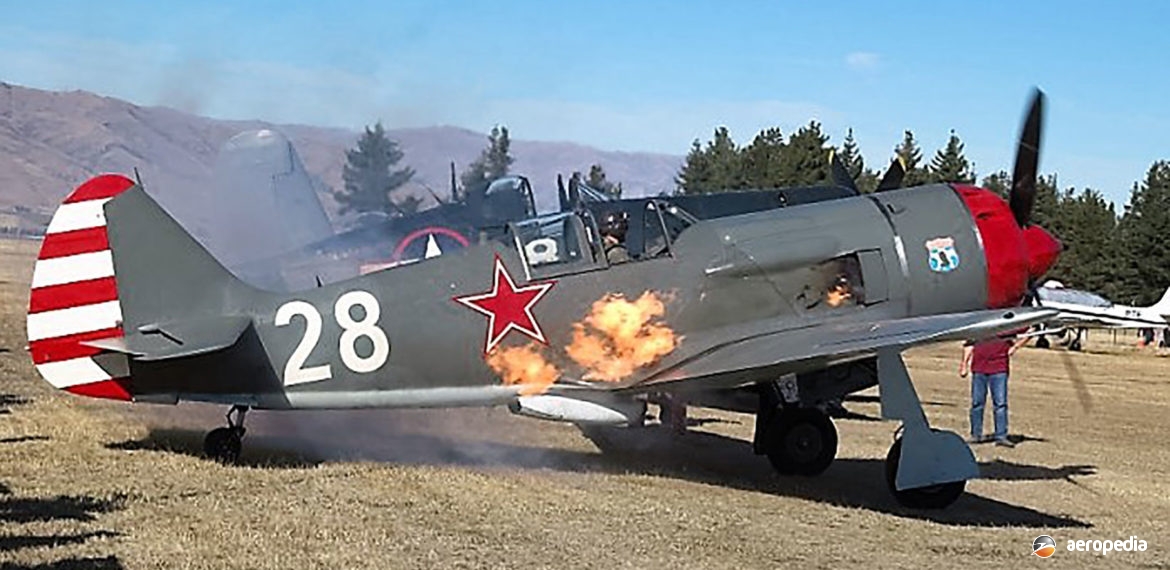Photograph:
Lavochkin LA-9 ZK-LIX (c/n 828) at Wanaka, NZ (Ron Cuskelly)
Country of origin:
Union of Soviet Socialist Republics
Description:
Single-seat fighter
Power Plant:
One 1,395 kw (1,870 hp) Shvetsov ASh-82FHV fourteen-cylinder two-row radial air-cooled engine
Specifications:
- Wingspan: 10.6 m (34 ft 9¼ in)
- Length: 9.2 m (30 ft 2¼ in)
- Height: 2.98 m (9 ft 8 in)
- Wing area: 17.71 m² (190.63 sq ft)
- Max speed at sea level: 689 km/h (428 mph)
- Max speed at 3,499 m (11,480 ft): 652 km/h (405 mph)
- Cruising speed: 502 km/h (312 mph)
- Initial rate of climb: 1,170 m/min (3,480 ft/min)
- Time to 4,999 m (16,400 ft): 4.2 mins
- Service ceiling: 11,235 m (36,400 ft)
- Max range: 1,735 km (1,078 miles)
- Empty weight: 2,660 kg (5,864 lb)
- Loaded weight: 3,425 kg (7,551 lb)
History:
One of the important design bureaus in the Soviet Union during World War II was that headed by Semyon Alexse’evich Lavochkin. His first fighter design was known as the I-22, making its maiden flight on 30 March 1939. Subsequently this fighter became known as the LaGG-1, the “GG” letters indicating that Lavochkin was assisted in the design by engineers Vladimir Gorbunov and Mikhail Gudkov. A number of modifications were made to the design and it entered production in 1940 as the LaGG-3, production aircraft commencing to be delivered in 1941.
The fuselage was built of Siberian birch frames with a plywood skin impregnated with phenol-formaldehyde, the fin being integral with the fuselage. The wings were two-spar wooden structures, control surfaces being metal frames with fabric covering. By 1942 the type was numerically one of the most important Soviet fighters serving on the Eastern front. Power plant was the 746 kw (1,100 hp) Klimov M-105P 12-cylinder VEE liquid cooled engine. Total production of the LaGG-3 was 6,528 aircraft.
In late 1941 an LaGG-3 airframe was fitted with a Shevtsov M-82A radial engine, thus becoming known as the La-5. First production aircraft of this model used LaGG-3 airframes but were modified to provide for an all-round vision canopy. The type made its operational debut at Stalingrad. This model was developed, later being fitted with a 1,231 kw (1,650 hp) M-82FN engine, becoming known as the La-5FN, operating in large numbers during the battle of Kursk and being flown by a number of Russian aces. Probably the most famous exponent of the series was Russia’s leading ace, Ivan Kojedub, who had 62 victories during World War II, his last being on an La-7, this aircraft being preserved in a museum in Russia.
Further development lead to the La-7. This was a more powerful and heavier armed variant of the La-5FN. The M-82FN engine now provided 1,324 kw (1,775 hp) for take-off, and armament was increased from two to three 20-mm cannon. Attempts were made to improve the performance by fitting a liquid-fuel rocket in the extreme rear fuselage, this boosting power for short periods. The La-7 was the ultimate refinement of the series. Its development was initiated in 1943 and embodied a number of refinements aimed at facilitating field maintenance, an increase in fire power by the fitting of three 20-mm Berezina B-20 cannon, and a revised wing structure. It was ordered into production in parallel with the La-5FN at factories in Yaroslavl and Moscow; and a tandem two-seat version, the La-7UTI, was built for conversion training and high-speed liaison work.
Subsequently the La-9 and La-11 were developed, the last production piston-engined fighters developed by Lavochkin, but these aircraft only bore a family resemblance to their forbears. They featured an entirely new structure, including a semi-monocoque metal fuselage and entirely new laminar-flow wings. The second prototype mounted four 23 mm Nudelman-Rikhter NR-23 cannon and was assigned the designation La-130, becoming the La-9 when adopted for series production. Both prototypes were flown during 1946 and were too late to see service in World War II. In July 1947 a two-seat conversion trainer, the La-9UTI, entered the flight test programme. Testing took place with PVRD-430 ramjets fitted under the wings, and a small number were fitted with RD-13 pulsating athodyds, or pulse jets, and became known as the La-9RD, these increasing maximum speed by 107 to 127 km/h (66 to 79 mph).
The La-11 was a specialised escort fighter and, apart from some aerodynamic refinements, differed little from the La-9, except in that small wingtip drop tanks were fitted, increasing fuel capacity to 1,100 litres (242 Imp gals). One La-11 was flown by a defecting V-VS pilot seeking asylum in Sweden on 18 May 1949. The La-9 and La-11 remained in Soviet, Chinese and North Korean service until the 1950s.
In 1994 it was mooted the Alpine Fighter Collection at Wanaka would received an La-7 for restoration from the Soviet Union but this did not occur. However, an ex Chinese Air Force La-9 arrived in the United Kingdom in mid-1996 for the Old Flying Machine Company at Duxford. This aircraft was purported to have served in the Korean War.
In 2000 it was conveyed to Pioneer Aero Restorations at Auckland, NZ for restoration to airworthiness, firstly being allotted the British registration G-BWUD but later becoming ZK-LIX for test flying. After completion of the restoration it was test flown for a short period and then shipped to the United Kingdom where it was based at Duxford for a period before returning to New Zealand in early 2004. It subsequently was demonstrated at a number of airshows, making its last appearance at Easter 2010, after which it was shipped to the Jerry Yagen collection in Virginia in the United States, where it joined a number of other World War II warbirds.

